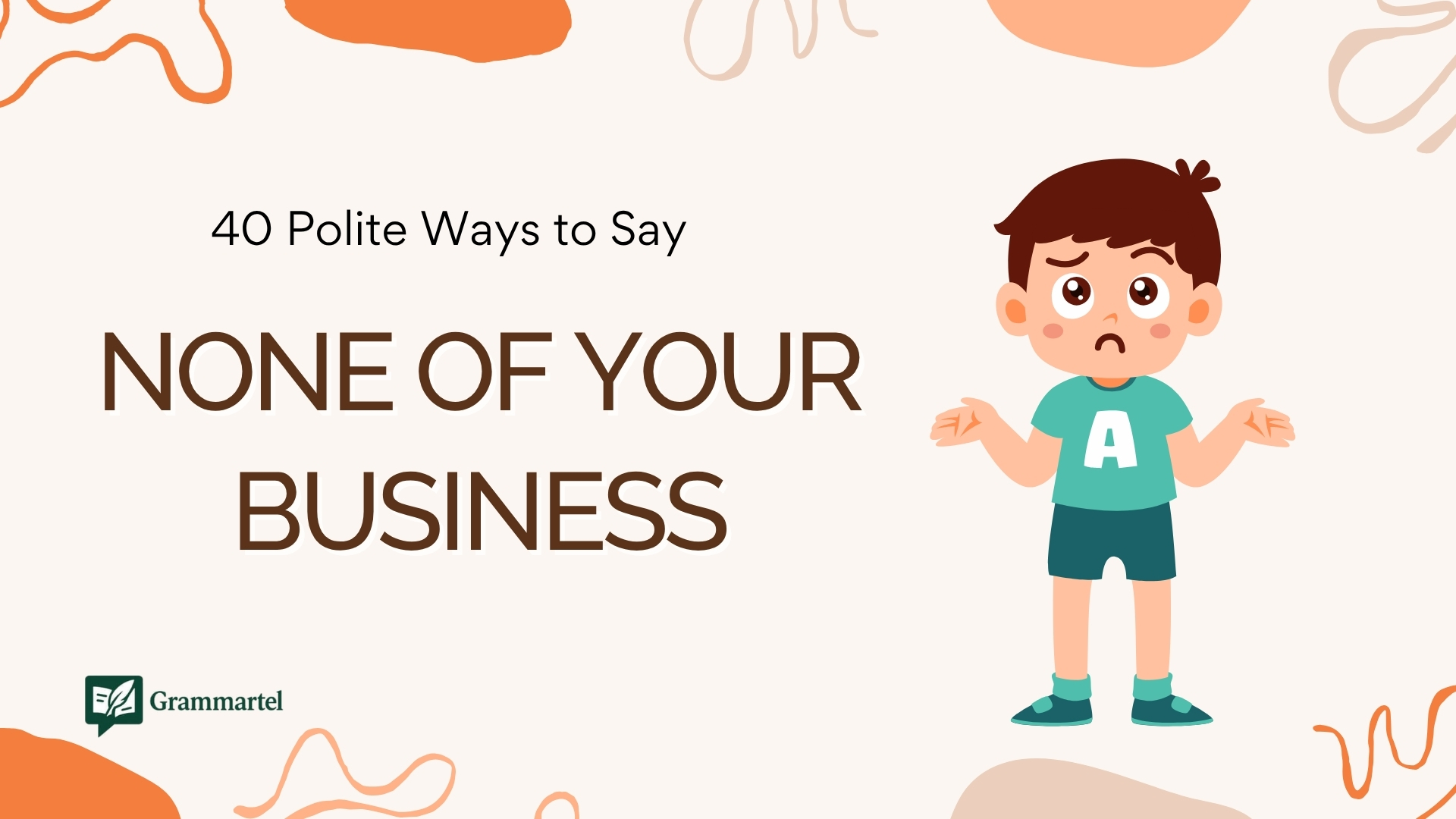Sometimes people ask things they really shouldn’t. Maybe it’s about your salary, love life, or personal choices—and let’s be honest, not everything is meant to be shared. But instead of snapping back with “It’s none of your business,” there are plenty of softer, more polite ways to draw the line. Whether you’re at work, chatting with friends, or dealing with nosy relatives, knowing how to say it kindly can save you trouble—and keep the peace.
What Does “None of Your Business” Mean?
“None of your business” means something is private and the other person shouldn’t ask about it. It’s a way to tell someone that the topic doesn’t concern them. People often use this when they feel a question is too personal or rude. It’s short and clear—but it can sound harsh if not said carefully.
When to Use “None of Your Business”
Use this phrase when someone asks about something you don’t want to share—like money, relationships, or personal choices. It’s best used when the person keeps pushing or crosses a line. But in friendly situations, it’s better to choose softer words. Being honest is good, but tone matters. You can protect your privacy without hurting someone’s feelings.
40 Polite Ways to Say “None of Your Business”
1. That’s personal.
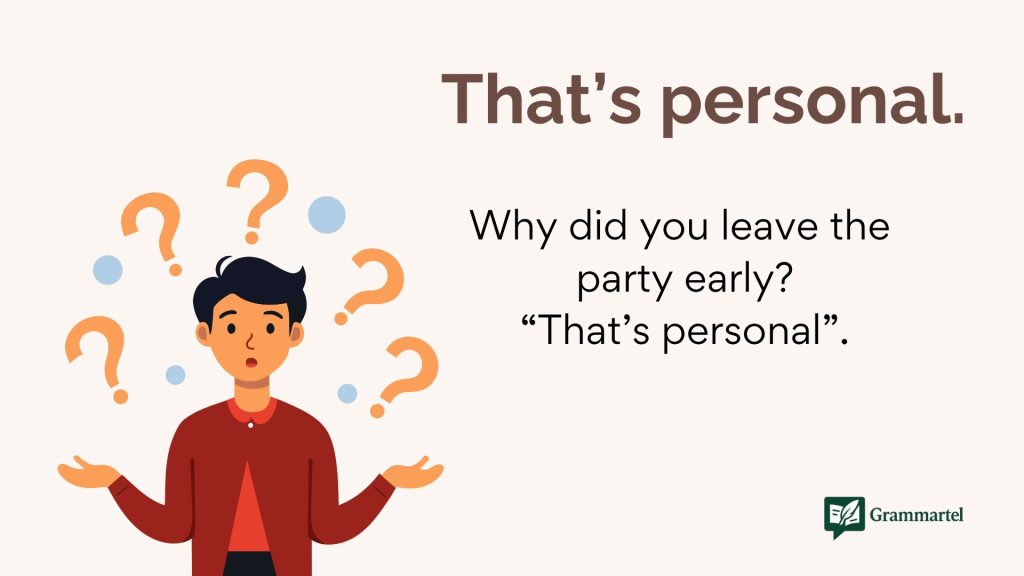
Meaning: It’s private.
Explanation: Used when something is too sensitive to share.
Example: “Why did you leave the party early?” — “That’s personal.”
Best Use: With someone overstepping subtly.
Worst Use: When someone’s genuinely concerned.
Tone: Polite but firm.
2. I’d rather not say.
Meaning: I don’t want to answer.
Explanation: A soft refusal to discuss the topic.
Example: “How much do you make?” — “I’d rather not say.”
Best Use: In professional settings or interviews.
Worst Use: When honesty is required.
Tone: Courteous, non-confrontational.
3. That’s not something I’m comfortable discussing.
Meaning: I won’t talk about it.
Explanation: Signals discomfort and sets a boundary.
Example: “Tell me about your breakup.” — “That’s not something I’m comfortable discussing.”
Best Use: When being pressed about emotional topics.
Worst Use: Casual small talk.
Tone: Honest, respectful.
4. Why do you ask?
Meaning: What’s your reason for asking?
Explanation: Deflects the question and puts the spotlight back.
Example: “Who were you texting?” — “Why do you ask?”
Best Use: When unsure of the asker’s intent.
Worst Use: With someone just being friendly.
Tone: Curious, slightly guarded.
Learn More : 40 Other Ways to Say “Thank You for Your Thoughtfulness” (With Examples).
5. That’s between me and me.
Meaning: It’s entirely private.
Explanation: Emphasizes how personal it is.
Example: “So what really happened at work?” — “That’s between me and me.”
Best Use: Close relationships with boundaries.
Worst Use: Formal settings.
Tone: Witty, protective.
6. Let’s talk about something else.
Meaning: I want to change the subject.
Explanation: Politely redirects the conversation.
Example: “So, are you two dating?” — “Let’s talk about something else.”
Best Use: When the conversation gets too personal.
Worst Use: When you’re being evasive in a serious chat.
Tone: Light, deflective.
7. I’m not getting into that.
Meaning: I refuse to talk about it.
Explanation: Direct and final.
Example: “Why were you fired?” — “I’m not getting into that.”
Best Use: When the topic is triggering or irrelevant.
Worst Use: When people deserve an answer.
Tone: Blunt, self-protective.
8. That’s irrelevant.
Meaning: It doesn’t matter here.
Explanation: Questions the importance of the topic.
Example: “What’s your political view?” — “That’s irrelevant.”
Best Use: Heated debates or inappropriate probing.
Worst Use: Friendly chats.
Tone: Assertive, potentially cold.
9. That’s not your concern.
Meaning: It doesn’t involve you.
Explanation: Sets a strong boundary.
Example: “Why didn’t you invite her?” — “That’s not your concern.”
Best Use: With nosy coworkers or acquaintances.
Worst Use: With close friends or family.
Tone: Defensive, serious.
10. I’m not answering that.
Meaning: I decline to respond.
Explanation: Clear refusal without drama.
Example: “Are you in debt?” — “I’m not answering that.”
Best Use: When pressed uncomfortably.
Worst Use: When transparency matters.
Tone: Neutral, direct.
11. I don’t feel like talking about that.
Meaning: I’m not in the mood to discuss it.
Explanation: Shows you’re not ready or willing to share.
Example: “Why did you quit so suddenly?” — “I don’t feel like talking about that.”
Best Use: When setting emotional boundaries.
Worst Use: If you’re expected to explain something important.
Tone: Honest, reserved.
12. That’s off-limits.
Meaning: That topic is not up for discussion.
Explanation: Makes the boundary clear with no wiggle room.
Example: “What’s your stance on your ex?” — “That’s off-limits.”
Best Use: For sensitive or personal matters.
Worst Use: When tone comes off too aggressive.
Tone: Firm, no-nonsense.
13. I don’t see how that’s relevant.
Meaning: That question doesn’t apply here.
Explanation: Challenges the relevance of the question.
Example: “Do you live alone?” — “I don’t see how that’s relevant.”
Best Use: In professional or formal conversations.
Worst Use: With people trying to get to know you.
Tone: Polite, slightly guarded.
14. I’m not obligated to share that.
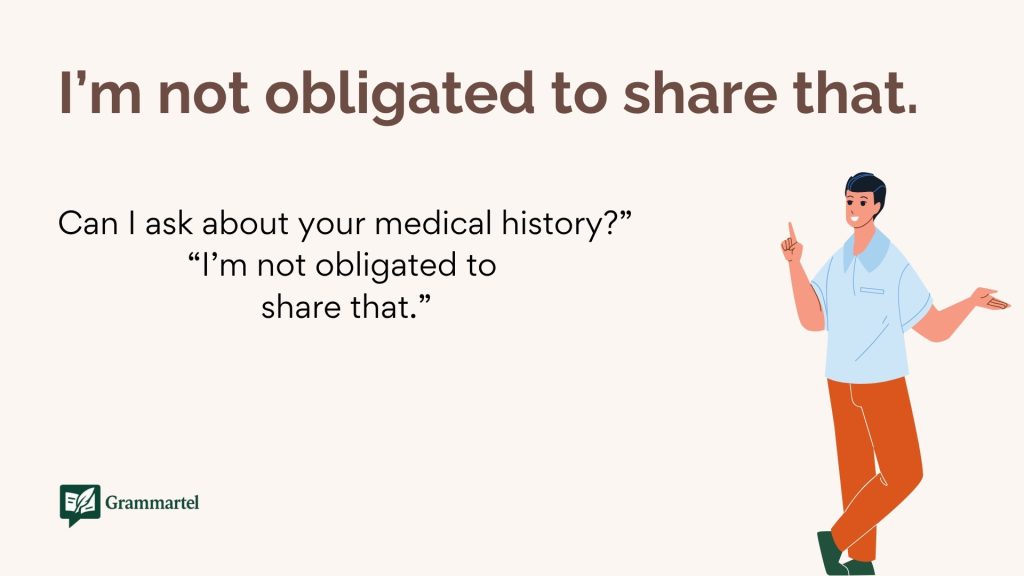
Meaning: I don’t have to tell you.
Explanation: Emphasizes your right to privacy.
Example: “Can I ask about your medical history?” — “I’m not obligated to share that.”
Best Use: In personal or legal matters.
Worst Use: In trusting relationships.
Tone: Assertive, boundary-setting.
15. Let’s leave it at that.
Meaning: We’ve said enough.
Explanation: Signals you’re done with the topic.
Example: “So what happened after that?” — “Let’s leave it at that.”
Best Use: After explaining a little but not wanting to go further.
Worst Use: When it feels dismissive.
Tone: Gentle but final.
16. I’m not sure that’s appropriate.
Meaning: That’s not a suitable question.
Explanation: Points out social or professional boundaries.
Example: “Did you vote for them?” — “I’m not sure that’s appropriate.”
Best Use: In workplace or formal settings.
Worst Use: With friends who value open discussion.
Tone: Respectful, reserved.
17. That’s kind of personal, don’t you think?
Meaning: You’re crossing a line.
Explanation: Highlights the inappropriateness of the question.
Example: “How many people have you dated?” — “That’s kind of personal, don’t you think?”
Best Use: With someone who may not realize they’re overstepping.
Worst Use: When sarcasm might be misunderstood.
Tone: Playful or pointed, depending on tone.
18. I’m keeping that to myself.
Meaning: I’m not sharing that.
Explanation: Light way to say “none of your business.”
Example: “How old are you really?” — “I’m keeping that to myself.”
Best Use: Friendly chats where you still want privacy.
Worst Use: With people who expect transparency.
Tone: Light, friendly.
19. I’ll pass on that question.
Meaning: I’m choosing not to answer.
Explanation: Sounds like a quiz show, but works in convo too.
Example: “So, how much rent do you pay?” — “I’ll pass on that question.”
Best Use: Casual settings where humor softens refusal.
Worst Use: In serious, required discussions.
Tone: Casual, non-confrontational.
20. That’s not up for discussion.
Meaning: I’ve decided we’re not talking about it.
Explanation: Makes your boundary very clear.
Example: “Tell me what you told your boss.” — “That’s not up for discussion.”
Best Use: When you need to shut down pushiness.
Worst Use: When people are trying to resolve conflict.
Tone: Stern, definite.
21. Some things are better left unsaid.
Meaning: It’s wiser not to talk about this.
Explanation: Suggests silence is better than speaking.
Example: “What happened between you two?” — “Some things are better left unsaid.”
Best Use: Emotional or dramatic situations.
Worst Use: If people are looking for closure.
Tone: Reflective, emotional.
22. I’m not at liberty to say.
Meaning: I’m not allowed to talk about it.
Explanation: Common in legal, medical, or work-related contexts.
Example: “Did he get fired?” — “I’m not at liberty to say.”
Best Use: When bound by confidentiality.
Worst Use: When it sounds like you’re hiding gossip.
Tone: Professional, careful.
23. That’s a private matter.
Meaning: It’s personal and not for discussion.
Explanation: States plainly that the topic is private.
Example: “How’s your divorce going?” — “That’s a private matter.”
Best Use: Legal or emotional topics.
Worst Use: When it sounds overly formal in casual chat.
Tone: Polite, formal.
24. That’s not really for public consumption.
Meaning: That’s not meant to be shared.
Explanation: Implies discretion.
Example: “What happened at the retreat?” — “That’s not really for public consumption.”
Best Use: In semi-formal environments.
Worst Use: When it feels too cryptic.
Tone: Wry, slightly humorous.
25. Let’s not go there.
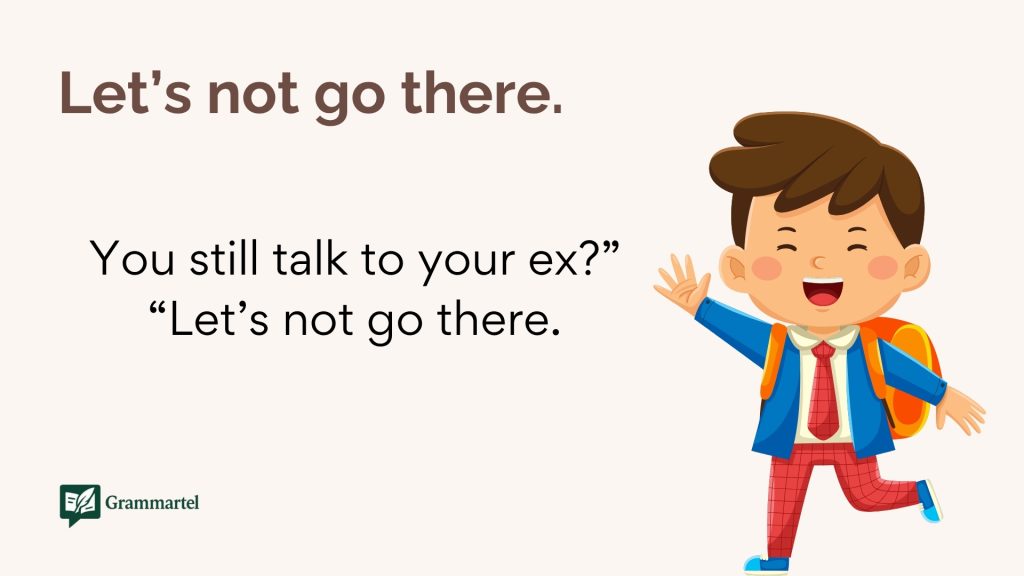
Meaning: I don’t want to talk about it.
Explanation: Warns that the topic is off-limits.
Example: “You still talk to your ex?” — “Let’s not go there.”
Best Use: Emotional or heated discussions.
Worst Use: When the other person’s being sincere.
Tone: Cautionary, potentially playful or serious.
26. That’s not something I talk about.
Meaning: I don’t ever discuss this topic.
Explanation: Makes it clear it’s a closed subject.
Example: “Tell me about your finances.” — “That’s not something I talk about.”
Best Use: Habitual boundary-setting.
Worst Use: When you need to be transparent.
Tone: Calm but immovable.
27. I like to keep that private.
Meaning: I prefer not to share that info.
Explanation: Emphasizes personal preference.
Example: “How old are your kids?” — “I like to keep that private.”
Best Use: Polite social deflection.
Worst Use: When the question is benign and routine.
Tone: Friendly, non-aggressive.
28. That’s not open for debate.
Meaning: I’ve made my decision and won’t discuss it.
Explanation: Shuts down argument before it begins.
Example: “Why didn’t you tell her?” — “That’s not open for debate.”
Best Use: Controversial or personal decisions.
Worst Use: During collaborative discussions.
Tone: Firm, borderline confrontational.
29. You don’t need to know that.
Meaning: It’s not information you’re entitled to.
Explanation: Bluntly tells them to back off.
Example: “How did you get that job?” — “You don’t need to know that.”
Best Use: When someone’s being nosy or rude.
Worst Use: With people who deserve transparency.
Tone: Blunt, defensive.
30. Let’s keep that off the record.
Meaning: This isn’t for sharing.
Explanation: Suggests the info shouldn’t be repeated or publicized.
Example: “Did you hear what happened?” — “Let’s keep that off the record.”
Best Use: With trusted people.
Worst Use: When secrecy creates suspicion.
Tone: Confidential, careful.
31. I’m not comfortable answering that.
Meaning: I feel uneasy talking about this.
Explanation: Uses vulnerability to set a boundary.
Example: “How’s your therapy going?” — “I’m not comfortable answering that.”
Best Use: With empathetic people who’ll respect boundaries.
Worst Use: In interrogative or high-stakes scenarios.
Tone: Honest, vulnerable.
32. I think I’ll keep that to myself.
Meaning: I’m choosing not to share.
Explanation: Casual refusal with a polite spin.
Example: “Did you vote?” — “I think I’ll keep that to myself.”
Best Use: Friendly or political conversations.
Worst Use: When transparency is important.
Tone: Mild, unbothered.
33. I don’t want to get into that.
Meaning: I don’t want to start that conversation.
Explanation: Avoids opening a can of worms.
Example: “What’s going on between you two?” — “I don’t want to get into that.”
Best Use: Emotionally charged subjects.
Worst Use: In therapy or deep conversation.
Tone: Avoidant, soft.
34. That’s not something I’m sharing.
Meaning: I’ve chosen not to disclose that.
Explanation: Clear boundary, no extra emotion.
Example: “What happened with the lawsuit?” — “That’s not something I’m sharing.”
Best Use: Legal or sensitive situations.
Worst Use: When a team is relying on your input.
Tone: Neutral, assertive.
35. Let’s just leave it alone.
Meaning: Stop asking.
Explanation: Gently discourages further questions.
Example: “What’s going on with your job?” — “Let’s just leave it alone.”
Best Use: Emotional fatigue or stress situations.
Worst Use: When people are sincerely trying to help.
Tone: Tired, peaceful.
36. Some things are just mine.
Meaning: That belongs to my private world.
Explanation: Subtly poetic way to say “back off.”
Example: “Tell me your biggest fear.” — “Some things are just mine.”
Best Use: In deeper or philosophical discussions.
Worst Use: When it sounds evasive or smug.
Tone: Reflective, intimate.
Explore More : 40 Professional Ways to Say “Thank You for the Explanation” (With Examples).
37. That’s not for public discussion.
Meaning: It’s not meant to be shared widely.
Explanation: Indicates it’s sensitive info.
Example: “What happened between you and the manager?” — “That’s not for public discussion.”
Best Use: Workplace or community settings.
Worst Use: Friendly banter.
Tone: Formal, serious.
38. I have my reasons.
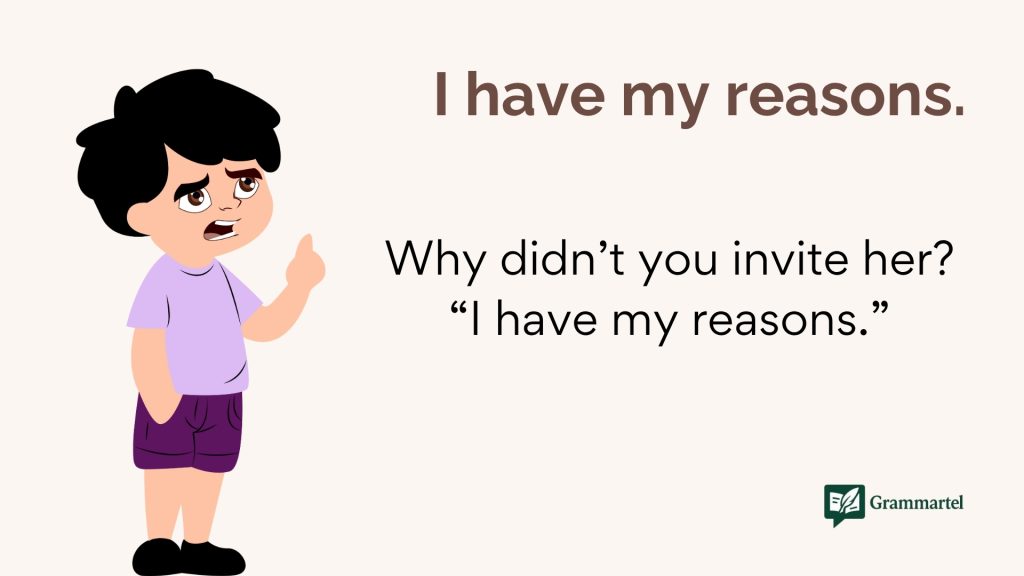
Meaning: I won’t explain myself.
Explanation: Suggests there’s a reason, but you won’t share it.
Example: “Why didn’t you invite her?” — “I have my reasons.”
Best Use: When you don’t owe an explanation.
Worst Use: When it seems mysterious or shady.
Tone: Vague, slightly evasive.
39. It’s complicated.
Meaning: The answer isn’t simple—and I won’t get into it.
Explanation: Politely sidesteps a topic.
Example: “Are you two still together?” — “It’s complicated.”
Best Use: Emotional or unclear situations.
Worst Use: When it leads to more questions.
Tone: Nuanced, noncommittal.
40. I’ll tell you when I’m ready.
Meaning: I’m not ready to talk now.
Explanation: Offers future openness, but not yet.
Example: “Why didn’t you show up yesterday?” — “I’ll tell you when I’m ready.”
Best Use: With friends or partners.
Worst Use: When people need urgent info.
Tone: Calm, future-facing.
Conclusion
Setting boundaries doesn’t have to be rude. With the right words, you can protect your privacy while still being respectful. The next time someone asks a question that’s a little too personal, you’ll have a polite way to handle it. It’s not about pushing people away—it’s about taking care of yourself and your space. And honestly, there’s nothing wrong with that.
Turning complexity into clarity Grammartel drives the change.

